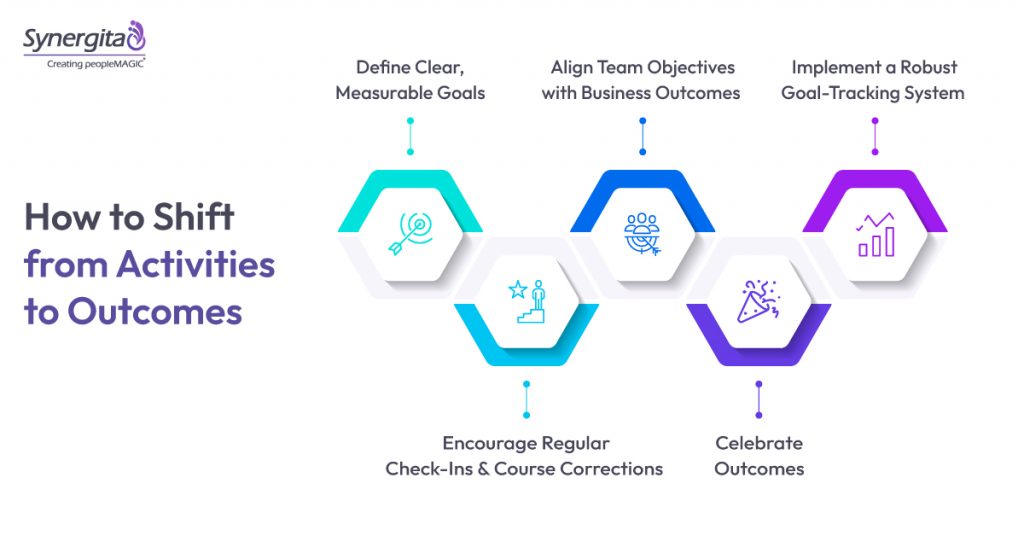Despite the relentless drive in digital initiatives, only 48% of enterprise projects actually hit their business outcome targets. This is a stark reminder that activities alone don’t guarantee impact.
If your current objective focuses on tasks, you need to elevate it by defining the real impact those tasks aim to create. The most powerful objectives are clear, motivating, and easy to remember. Take a step back, simplify the language, and articulate the true purpose behind your team’s efforts. What difference will achieving this objective make? Many organizations are recognizing that simply “staying busy” does not always translate to meaningful progress. Instead, businesses are shifting their focus from the tasks they perform to the results they want to achieve, aligning their efforts toward impactful outcomes. This approach, which reflects the principles behind agile goal-setting frameworks, can transform how teams operate, track progress, and drive long-term growth.
Why Shifting Focus Matters
Focusing on outcomes rather than activities fundamentally changes how a business functions. Activity-based strategies, while often measurable and easy to track, can lead to wasted time, effort, and resources if not aligned with larger business goals. By concentrating on specific results, businesses foster a culture of accountability, purpose, and agility, which are essential for thriving in a competitive landscape.
Activities are the steps you take, while outcomes are the results of those steps. For example, a sales team may make hundreds of calls per week (activity), but if those calls don’t lead to increased conversions or client acquisitions (outcome), the activity alone doesn’t contribute to the company’s growth goals.
Benefits of Focusing on Outcomes
- Enhanced Accountability and Transparency: When a business centers its strategy on outcomes, accountability naturally increases. Team members understand not only what they need to do but also why it matters. This shift builds a transparent environment where individuals are aware of how their work contributes to the organization’s overarching goals, motivating them to prioritize high-impact tasks.
- Improved Resource Allocation: Time, money, and manpower are finite resources. Organizations that prioritize outcomes can allocate these resources more effectively. By understanding which results lead directly to growth, companies can avoid spending on activities that don’t drive results and instead focus on projects that align with business goals.
- Agility and Flexibility: A results-oriented approach fosters agility. Rather than sticking rigidly to a set of activities, teams can pivot and adjust their strategies to achieve the desired outcome, making them more resilient to change. This agility is especially valuable in dynamic markets where business priorities may shift rapidly.
- Increased Employee Engagement: When employees understand the impact of their work, engagement tends to increase. Instead of feeling like “cogs in the machine”, team members gain a sense of purpose as they see their contributions leading to tangible results. This can improve job satisfaction and retention while boosting morale across the organization.
- Clear Pathways to Success: Organizations that focus on outcomes establish a clear vision of success. Activities can be ambiguous, and even when completed, may not provide the insight needed to measure growth. With a results-driven approach, however, the organization has a concrete way to assess whether objectives have been met, creating a roadmap for continuous improvement and growth.
How to Shift from Activities to Outcomes

Shifting to an outcome-based mindset isn’t just about changing metrics; it requires a shift in company culture and strategy.
Here’s how organizations can start making the transition:
- Define Clear, Measurable Goals
A vague target, such as “increase brand awareness”, doesn’t provide a concrete outcome to measure success. You could try to reframe it to “increase website traffic by 40% in three months” or “acquire 5,000 new social media followers in one year”.
- Align Team Objectives with Business Outcomes Ensuring that every team’s objectives contribute to the broader organizational goals is essential. For example, if the goal is to drive revenue growth, a marketing team can aim to generate leads through a targeted campaign, while the sales team focuses on converting those leads into clients.
- Implement a Robust Goal-Tracking System
Leveraging technology can simplify goal tracking and keep teams focused on outcomes. OKR tracking software, like Synergita OKR, is designed to help teams stay aligned with strategic goals, measure their progress, and adjust their activities to ensure they stay on track.
- Encourage Regular Check-Ins and Course Corrections Continuous monitoring of progress is key. Regular check-ins, whether weekly or monthly, allow teams to assess their current activities and determine if they’re contributing effectively to the desired outcome.
- Celebrate OutcomesRecognizing and rewarding teams based on results encourages a focus on outcomes and motivates teams to concentrate on meaningful goals.
Achieving Agile Business Growth with Synergita OKR
The journey toward agile business growth involves a shift in mindset. By adopting a solution like Synergita OKR, businesses can efficiently track, manage, and align their goals at every level of the organization. Synergita OKR empowers teams to focus on results, enhancing accountability, resource allocation, and agility.
As more organizations recognize the importance of tracking outcomes over activities, Synergita OKR serves as an invaluable tool in this transition. The platform enables goal-setting, outcome tracking, and progress alignment, ensuring that everyone in the organization is working toward common objectives. This outcome-based approach not only promotes agile growth but also cultivates a culture where every team member contributes meaningfully to the organization’s success.
